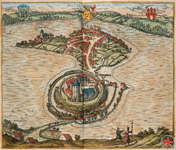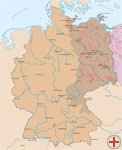


Slavic tribes settled throughout the eastern parts of
present-day Germany. The Main-Regnitz-Wends had already
been brought under Frankish sovereignty in the 8th century.
The conquest of the Slavic territories east of the Elbe,
by contrast, occurred at the beginning of the Slavic
castle-building period.

 To defend themselves against the
Frankish-German Empire the inhabitants erected numerous
ringworks of earth and timber in the time between the 8th and
the 12th centuries. At first they built extensive refuge forts,
later smaller complexes and fortified sanctuaries.
Houses and wells give evidence of permanent settlement,
while finds of weapons, spurs and jewellery bear witness
to an upper class that became assimilated and in some cases
ruled – in Mecklenburg – until 1918. In other places
the East Frankish conquerors built Slavic-style hill forts
as their seat of power. Most of these fortifications were
destroyed, while others – as in Brandenburg, Oldenburg or
Spandau – formed the core of communities with their "Kietze",
or feudal service settlements, which later evolved into cities.
To defend themselves against the
Frankish-German Empire the inhabitants erected numerous
ringworks of earth and timber in the time between the 8th and
the 12th centuries. At first they built extensive refuge forts,
later smaller complexes and fortified sanctuaries.
Houses and wells give evidence of permanent settlement,
while finds of weapons, spurs and jewellery bear witness
to an upper class that became assimilated and in some cases
ruled – in Mecklenburg – until 1918. In other places
the East Frankish conquerors built Slavic-style hill forts
as their seat of power. Most of these fortifications were
destroyed, while others – as in Brandenburg, Oldenburg or
Spandau – formed the core of communities with their "Kietze",
or feudal service settlements, which later evolved into cities.


